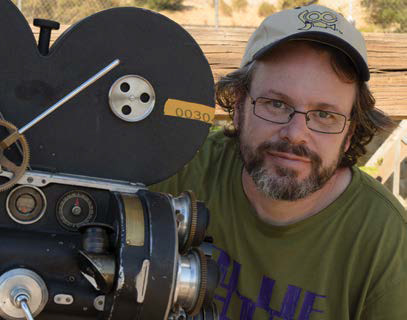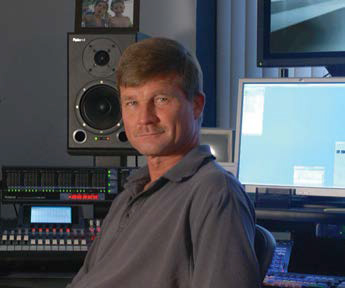The Perils of 4K

Jay Ankney
It’s a 4K world, right? New 4K cameras are popping up all around, there are giant 4K displays available, and 4K is becoming a standard for digital cinema presentations. But wait a minute. Haven’t we been down a similar path before?
We live in an industry easily swayed by the latest shiny bauble, but while 4K can be a powerful production tool, is it for everyone?
Ramy Katrib, founder of Digital Film Tree, a full service post-production facility and consulting business in the middle of Hollywood, was responsible for creating one of the first 4K masters for “The Sarah Silverman Program” in 2008, which was shot on a RED One camera at 4K. Katrib is one of the most renowned innovators in the post business, having been an early adopter of Final Cut Pro for professional post work, although these days, Digital Film Tree is brand-agnostic in the services it provides its clients.
NOT SO FAST
Katrib may be a leader in the business, but he doesn’t jump on bandwagons.

Ramy Katrib “We are working on eight television shows right now including ‘NCIS: Los Angeles,’ ‘Perception,’ and ‘Cougar Town,’ among others,” he said, “but none of those clients have requested 4K masters.”
Katrib has had meetings with at least two studios who were inquiring about 4K workflows, but that was just as a consultant. Neither has commissioned 4K mastering yet.
The professional video industry's #1 source for news, trends and product and tech information. Sign up below.
“The most popular camera in TV production is currently the ARRI Alexa which doesn’t shoot 4K,” he said. “Of course, you could always post-process its recordings to 4K, but that doesn’t seem to make a lot of sense. The broadcasters are going to send it out as a highly compressed signal, so home viewers would not benefit from the resolution of the source material. That’s why a lot of people think that 4K home viewing will probably come through the Internet before it gets broadcast.”
Freelance DP Art Adams shoots mostly commercials in the San Francisco area and is well aware of the lure of 4K, but feels it is sometimes just a siren’s call.
“I like to use the tools that are appropriate,” Adams said. “But a lot of commercials these days are going straight to YouTube or websites so anything more than standard-definition just generates a lot of extra data. Since these short-form projects have a short life span, shooting them in 4K would be overkill, and budgets are pretty tight these days.”

Art Adams In Fayetteville, Ark., Matt Jeppsen is the founder of the FreshDV website and a DP working in music videos when he’s not shooting commercials. Jeppsen understands that camera manufacturers are trying to sell what they produce, but most of the time, the directors who hire him will call for 1080p delivery.
“It’s not like someone is going go back to the original scans 60 years from now like in the theatrical world,” he said. “We may use a 4K camera for slo-mo or stills, but for principle photography I often shoot with a Canon EOS C-300 and may even deliver in 720p. Everyone I’ve talked to balks at the cost and time of cutting 4K files.”
Jeppsen described an upcoming production where they would be shooting a live country music event docu-style with an editor on-site cutting highlight packages. “I would never recommend 4K for an assignment like that unless there was a specific, pressing need,” he said. “Sure, 4K permits reframing and stabilization, but the C-300 is more adaptable to our ‘run-and-shoot’ style.”
A ‘PIPE DREAM’
Terence Curren, president of the Burbank, Calif. post-production house AlphaDogs, feels that the concept of delivering 4K to the home is a pipe dream on many levels.
“In addition to the lack of bandwidth, the real question is what the maximum resolution is that the human eye is capable of receiving,” Curren said. “I have a 65-inch HDTV at home and I’d have to be sitting closer than five feet to perceive the difference between 1080 and 4K. That is not a comfortable viewing position, and if at a greater distance you can’t tell the difference, what is the point?”

Terence Curren
You can find 4K viewing charts all over the Web that relate perceived resolution to viewing distance, and Curren’s suggestion is to use them to work backwards. “Let’s find out what the magic resolution is for maximum viewing clarity at a distance that is based on real screen size. If that is 8K or 4K, so be it. But I suspect it is going to be a lot less than 4K.”
Curren thinks the cart is pulling the horse when driving 4K to market.
“We seem to be saying that since the TV manufacturers are hurting, and 3D didn’t bail them out, let’s try 4K with every intention of upping it to 8K in a few years,” he said. “But that is not a concern for the quality being delivered to the end user. If the viewer cannot experience the improvement, excessive resolution is a waste of bandwidth and investment.”
Curren cites technology like Dolby Vision that can enhance the appreciated image quality of our current video systems.
“It has more to do with better pixels, not more pixels,” he insists. “How about 4:4:4 color at 12-bit? Higher dynamic range? Wouldn’t expanded dynamic range be a more beneficial way to improve the home viewing experience than higher resolution?”
As the owner of Bourbon Street Productions in Colorado Springs, Colo., and a freelance videographer, John Bourbonais reminds us that most of our home viewing is via cable and its infrastructure isn’t up to the challenge of 4K.

John Bourbonais “I think HD or 2K is perfectly adequate,” Bourbonais says. “As a home consumer, I am aware that we don’t yet even have 1080p home deliverables. So now we jump to 4K? I don’t think so.”
At a 4K demonstration he recently saw in Denver, Bourbonais stood in front of an 85-inch display with four other pro videographers. As he described it, 4K was on the left and 1080p on the right, separated by a vertical bar that would move horizontally across the screen.
“The question was whether we could tell the difference from a home-viewing distance of about eight feet,” Bourbonais recalls. “There were two ‘maybes’ and three ‘no’ responses in our group. I personally saw no difference, yet I am very familiar with scrutinizing digital images on a screen.”
Here’s the final irony. There is a good chance that the next home display I purchase will indeed have 4K resolution or better. But with my current 3DTV rated to last up to 100,000 hours, it’s probable that some kind of screen presenting 4K or higher will be cheap as matches by the time I need to buy it.
Jay Ankeney is a freelance editor and post-production consultant in Los Angeles. He may be contacted atjayankeney@mac.com.
